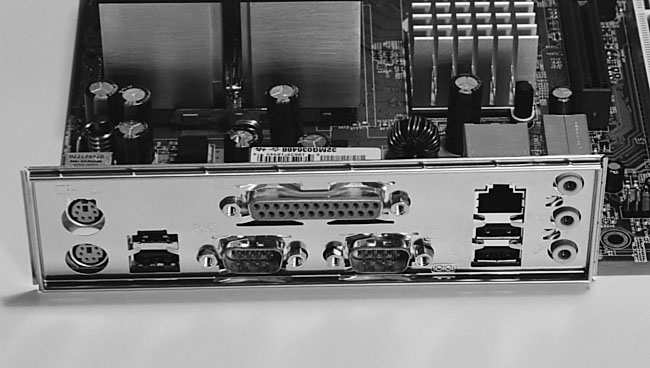 |
|
 |
How to Build Your Own PC - Save A Buck And Learn A Lot 9 Chapter 2: Component Overview 9 Case and Power Supply |
|
I/O, I/O, it’s Into or Out of the Computer We Go
When placing the mainboard inside the case, it will be necessary to push the mainboard toward what’s called the I/O shield (input/output shield) of the case, as seen in Figure 14.
The I/O shield usually has several metal fins sticking out toward the mainboard. Various connectors that are permanently attached to the mainboard will protrude from the I/O shield. The serial ports, parallel port, PS/2 keyboard connector, and PS/2 mouse connector are among these I/O devices that protrude from the I/O shield. USB ports and Firewire IEEE 1394 connectors are other connectors that might protrude from the I/O shield. (If you’re big into video editing, you might want to select a mainboard with a Firewire port. Otherwise, you can purchase a PCI card that gives your system a Firewire connection.)
|
The metal fins on the I/O shield ground the I/O connectors to the case and they will offer some resistance to the mainboard when it is placed. This is natural. Just manipulate and push the mainboard toward the I/O shield until the I/O device connectors protrude and the mainboard holes line up with the case standoffs.
If all the mainboard holes appear to be off just a bit, you probably need to push the mainboard more toward the I/O shield for it to sit properly. The I/O shield might provide some resistance and push the mainboard away from the shield. Just hold the mainboard in place as you secure it with a screw to the case.
We should note that the I/O shields are easily removable, and an I/O shield should come with your mainboard. Just replace the I/O shield that is part of the case with the one that comes with your mainboard. This might be necessary, for example, if your mainboard offers several USB connections through the I/O shield and the I/O shield that comes with the case won’t accommodate them. Or your mainboard might have connectors for built-in sound or a network connection that wouldn’t be accommodated by the standard I/O shield.
Some newer mainboards are using USB connectors in place of “legacy” keyboard and mouse connectors. If you purchase one of these boards, you’ll need to use USB keyboards and mice or purchase adapters to use your older keyboard and mouse components.
Usually, when you open a PC case by taking off one side, you want to take off the side of the case opposite the mainboard. This allows you to easily install the mainboard and other components.
To see which side of the case must come off, examine the back of the case and find the side that contains the I/O shield. The side with the I/O shield is the side on which the mainboard sits. Take off the panel on the other side to get easy access to everything. There is usually little reason to remove the side of the case that secures the mainboard. And, if the PC is already built, PCI and other expansion cards will usually prevent the side with the mainboard from coming off conveniently. You’d need to remove all the PCI cards before you could take that side off.
Some cases have a removable panel to which you first attach the mainboard. Then, the panel is replaced and attached to the case. Other cases just have the mainboard attach directly to the side of the case.
Choose a quality case. It can be used for years and through many upgrades.
|
Home - Table Of Contents - Contact Us
How to Build Your Own PC (/byop/) on PCGuide.com
Version 1.0 - Version Date: May 4, 2005
Adapted with permission from a work created by Charlie Palmer.
PCGuide.com Version © Copyright 2005 Charles M. Kozierok. All Rights Reserved.
Not responsible for any loss resulting from the use of this site.





